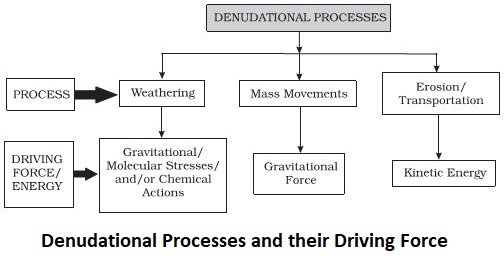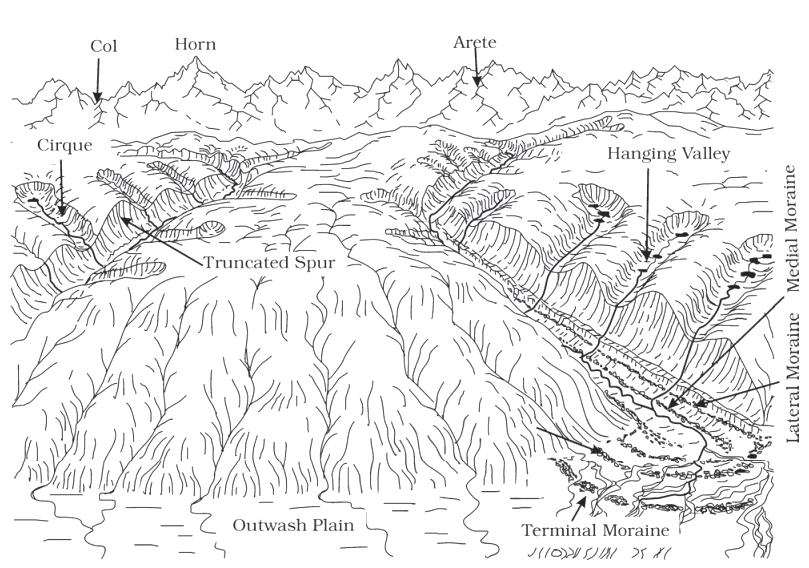-
23 Jan 2023
GS Paper 1
Geography
Day 65
Question 1. Two form of Geomorphic Processes bring changes on the earth. Illustrate. (250 words)
Question 2. Describe the various landforms created by glaciers and the process of their formation. (250 words)Answer 1
Approach
- Briefly define geomorphic processes.
- Explain the two types of processes and their further classification with diagrams.
- Conclude suitably.
Introduction
The term geomorphic relates to the form of the landscape and other natural features of the earth’s surface. The forces causing physical and chemical changes on earth's surface are known as geomorphic processes. All changes take place under the influence of certain forces working continuously within the earth as well as over the surface of the earth.
Body
The forces working over the earth’s surface are known as exogenic forces, while those working within the earth’s surface are called endogenic forces. They are further classified as per the diagram below:
- Endogenic movements: The energy emanating from within the earth is the main force behind endogenic geomorphic processes. The earth movements are mainly of two types: diastrophism and sudden movements.
- Diastrophism: All processes that move, elevate or build up portions of the earth’s crust come under diastrophism. They include:
- Orogenic processes involving mountain building through severe folding and affecting long and narrow belts of the earth’s crust. They act tangentially to the earth's surface, as in plate tectonics.
- Tension produces fissures (force acting away from a point in two directions)
- Compression produces folds (force acting towards a point)
- Orogenic processes involving mountain building through severe folding and affecting long and narrow belts of the earth’s crust. They act tangentially to the earth's surface, as in plate tectonics.
- Epeirogenic processes involving uplift or warping of large parts of the earth’s crust, thus it is a continental building process. They act along the earth’s radius and thus are also called radial movements.
- When direction of movements is towards each other, it is subsidence.
- When it is away, it is uplifted from the center. For ex: Raised beaches, elevated wave-cut terraces, sea caves, etc.
- Sudden movements: They cause considerable deformation over a short span of time and may be of two types: earthquakes and volcanoes.
- Diastrophism: All processes that move, elevate or build up portions of the earth’s crust come under diastrophism. They include:
- Exogenic forces are a direct result of stress induced in earth materials by various forces that come into existence due to sun’s heat. They may face shear stresses that break rocks and other earth materials or molecular stresses caused due to temperature changes.
- All the exogenic geomorphic processes are covered under a general term, denudation.
- Weathering, mass wasting/movements, erosion and transportation are included in denudation.
Conclusion
Thus, the above-mentioned geomorphic processes are critical to provide the unique structure of Earth’s crust.
Answer 2
Approach
- Start by defining geomorphic processes.
- Describe the various landforms created by glaciers and the process of their formation.
- Conclude suitably.
Introduction
The endogenic and exogenic forces causing physical stresses and chemical actions on earth materials and bringing about changes in the configuration of the surface of the earth are known as geomorphic processes.
- Diastrophism and volcanism are endogenic geomorphic processes.
- Weathering, mass wasting, erosion and deposition are exogenic geomorphic processes.
Body
- Masses of ice moving as sheets over the land or as linear flows down the slopes of mountains in broad trough-like valleys are called glaciers. Glaciers move because of the force of gravity.
- Erosion by glaciers is tremendous because of friction caused by sheer weight of the ice. As glaciers continue to move, debris gets removed, divides get lowered and eventually the slope is reduced to such an extent that glaciers will stop moving leaving only a mass of low hills and vast outwash plains along with other depositional features.
Erosional Landforms:
- Cirque: The cirques quite often are found at the heads of glacial valleys. The accumulated ice cuts these cirques while moving down the mountain tops. They are deep, long and wide troughs or basins with very steep concave to vertically dropping high walls at its head as well as sides.
- A lake of water can be seen quite often within the cirques after the glacier disappears. Such lakes are called cirque or tarn lakes.
- There can be two or more cirques one leading into another down below in a stepped sequence.
- Horns and Serrated Ridges: Horns form through headward erosion of the cirque walls. If three or more radiating glaciers cut headward until their cirques meet, high, sharp-pointed and steep-sided peaks called horns form.
- The divides between cirque side walls or head walls get narrow because of progressive erosion and turn into serrated or saw-toothed ridges sometimes referred to as arêtes with very sharp crest and a zig-zag outline.
- Glacial Valleys/Troughs: Glaciated valleys are trough-like and U - shaped with broad floors and relatively smooth, and steep sides.
- The valleys may contain littered debris or debris shaped as moraines with swampy appearance. There may be lakes gouged out of rocky floor or formed by debris within the valleys.
- There can be hanging valleys at an elevation on one or both sides of the main glacial valley. The faces of divides or spurs of such hanging valleys opening into main glacial valleys are quite often truncated to give them an appearance like triangular facets. Very deep glacial troughs filled with sea water and making up shorelines (in high latitudes) are called fjords/fiords.
Depositional Landforms
- Moraines: They are long ridges of deposits of glacial till.
- Terminal moraines are long ridges of debris deposited at the end (toe) of the glaciers.
- Lateral moraines form along the sides parallel to the glacial valleys. The lateral moraines may join a terminal moraine forming a horse-shoe shaped ridge.
- The moraine in the centre of the glacial valley flanked by lateral moraines is called medial moraine.
- Eskers: When glaciers melt in summer. These waters accumulate beneath the glacier and flow like streams in a channel beneath the ice. Such streams flow over the ground. Very coarse materials like boulders and blocks along with some minor fractions of rock debris carried into this stream settle in the valley of ice beneath the glacier and after the ice melts can be found as a sinuous ridge called esker.
- Outwash Plains: The plains at the foot of the glacial mountains or beyond the limits of continental ice sheets are covered with glacio-fluvial deposits in the form of broad flat alluvial fans which may join to form outwash plains of gravel, silt, sand and clay.
- Drumlins: Drumlins are smooth oval shaped ridge-like features composed mainly of glacial till with some masses of gravel and sand. The long axes of drumlins are parallel to the direction of ice movement. One end of the drumlins facing the glacier called the stoss end is blunter and steeper than the other end called tail. The drumlins form due to dumping of rock debris beneath heavily loaded ice through fissures in the glacier. The stoss end gets blunted due to pushing by moving ice. Drumlins give an indication of direction of glacier movement.
Conclusion
The glaciers are powerful forces of nature that have shaped the Earth's surface in various ways. The formation landforms are a gradual process that occurs over thousands of years as glaciers move and erode the land. The movement of ice and sediment, along with the effects of meltwater, all contribute to the creation of these unique landforms.







